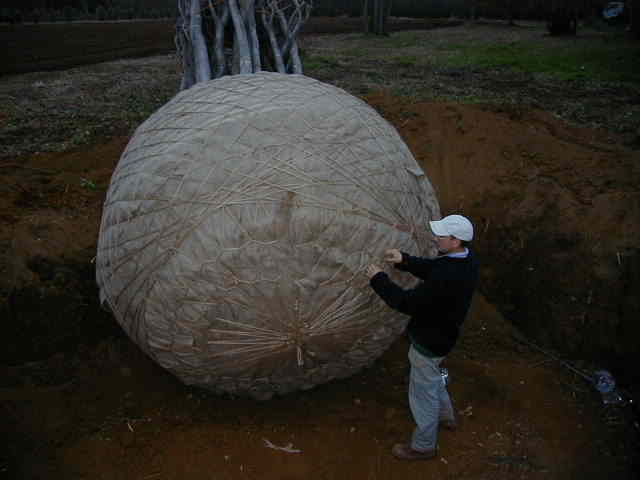上の写真は麻布と麻縄を使って根巻きした根鉢の一ヶ月後の状態です。
麻布の隙間から放射状に発根した様子が見られます。
この後、麻布と麻縄は、微生物により分解されて木の養分になりま
An example of a rootball that has been bound with hessian and hemp rope.
The root condition is good and evenly spread. Hessian can be left on to break down in the ground after planting becoming food for the tree.
欧米ではネットのようなものを使って簡単に根鉢をラッピングすると聞きますが、私はそれを真似ようとは思いません。
その理由の一つは、根鉢のサイズを選ぶそれに比べ根巻きは一種類の麻布と麻縄があれば殆どあらゆる大きさの根鉢を包むことが出来るように汎用性に優れていることです。
次に植え付け時に取り外しの
必要がない簡易性、また根を土と一緒に硬く固定出来るので運送時の根の傷みも少ないこと等が挙げられます。
In Europe and America tree root-balls are often bound using hessian and wire netting.
In Japanese style wrapping the materials are adaptable because they can be used to bind the rootballs of both large and small trees. When the trees are planted the wrapping can be left on to rot in the ground. The materials are also nice to work with and root-ball wrapping can be made to look artistic for garden trees.
造園業者の行う伝統的な根巻きは、美観をも目的としますが、我々緑化樹木生産者の行う根巻きは、輸送に耐えられる強度と低コストの両立を目的とする簡素で合理的なものです。
しかし、最小限の縄で最大の強度を得ようとした結果、美しい縄の模様が出来上がります。
It is important that root-ball wrapping is fast and strong, The materials are also nice to work with and root-ball wrapping can be made to look good or even artistic for garden trees.

This multi-stemed Zelkova root-ball was 2.8 meter wide and the tree was 15 meters tall. The finnished root-ball looks artistic.